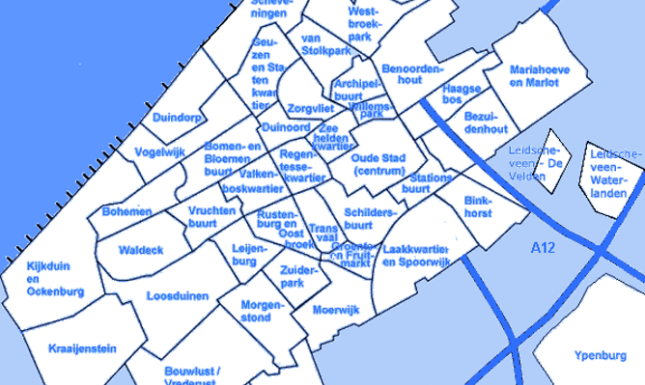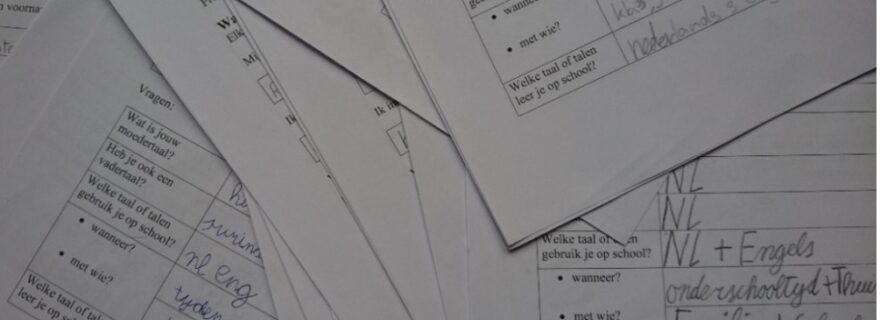Multilingual schoolchildren in The Hague
Ingrid Tieken-Boon van Ostade visited a primary school in Wateringse Veld, where she taught and learned from the schoolchildren about multilingualism in The Hague.
This year’s Dies Natalis programme Meet the Professor took me to Wateringse Veld, a fairly new suburb at the very south of The Hague.


The Hague has the highest number of inhabitants with a migration background of The Netherlands (allecijfers.nl), currently comprising 56.2% of its population (Den Haag in Cijfers). At 49.1%, Wateringse Veld is a little below the average.
Linguistic roots
The Dies programme takes Leiden University into the classroom, to teach seventh-graders about academic research. My plan was to raise awareness among schoolchildren of the multilingual nature of The Hague, and as a starting point I took the Sayings Route, a project I developed with LUCL students a few years ago. A website was developed for it during Leiden University’s 444th anniversary year. The route comprises 33 sayings in different languages, and lines the streets from Hollands Spoor railway station to Chinatown. I launched the website at another Meet the Professor event two years ago, and discovered its usefulness as an educational tool that allows children to display their skills in languages like Arabic or Turkish, and increases positive awareness of their linguistic roots.
This time my lesson plan consisted of an introduction to my Languages of The Hague project, demonstrating the Sayings Route website, and making the children interview each other to discover what languages they used at home, in school or on the street. Background to all this was a study by Guus Extra et al. (2001) among primary and secondary school children to establish which home languages were used in The Hague. The study produced 88 languages alongside Dutch, with the Top 5 comprising Turkish, Hind(ustan)i, Berber, Arabic and English. Today, this overview is no longer accurate due to recent immigration processes, particularly since the expansion of the EU during the 2000s. A small-scale replication of this study by Marjolein Voorwinden called “De andere talen van Den Haag” (BA thesis, 2017) confirmed this, showing that Polish had meanwhile entered the list of most frequent languages spoken in The Hague. But The Hague is the most segregated city of The Netherlands, and Voorwinden’s three schools were situated in socio-economically highly diverse districts: Statenkwartier, Regentessekwarter and Transvaal (see map). All this made me curious about the multilingual situation of the school in Wateringse Veld.
Interviews
The children’s completed interviews showed that 15 out of 25 of them came from all-Dutch families. Home languages are not routinely listed in children’s school records, but 40% children with a migration background, somewhat lower than that of the district itself, agreed with the teacher’s estimate beforehand.
The ten children concerned came from multilingual backgrounds that included Turkish, “Moroccan” (Berber?), “Pakistani” (Urdu?), “Hindi” (Sarnámi?), “Surinamese” (Sranan Tongo or Sarnámi), Papiamentu (called “Papiaments”, so probably the variety spoken on Aruba), German, “Egyptian” (Egyptian Arabic?) and Indonesian – quite a diverse collection of languages. Polish was not mentioned, despite Wateringse Veld’s closeness to the Westland glasshouse industry where many Polish migrants work. Nijhoff (2017:627) indeed writes that Polish migrant workers tend to live elsewhere: Laak and Spoorwijk, Transvaal, Rustenburg/Oostbroek, Schilderswijk and Valkenboskwartier (map).
What languages do they speak on the street or with friends? Surprisingly for their age, some children mentioned straattaal (multicultural urban Dutch). This suggests that straattaal is worth studying for The Hague as well (see also Khalid Mourigh’s research). Other children said they wanted to learn Korean, and were even familiar with Duolingo. During the discussion I was asked whether Haags is an actual language, so I explained the difference between languages and dialects/accents. Haags is the first language along the Sayings Route, and this possibly prompted the question. Most children knew about the Haagse Harry statue in the city centre, but none of them spoke Haags.
Set in stone
Next year, I will register for the Meet the Professor programme again, to learn more about the languages spoken by The Hague’s seventh-graders and their parents. My aim is not to collect material for an academic publication. Such a project would require a different approach, similar to the study undertaken by Extra et al. (2001). It is probably harder today to gain access to so many schoolchildren (ca. 45% of all The Hague’s primary and secondary school children, 2001:17), but a replication of the original investigation is definitely worthwhile. Results will show how the linguistic makeup of The Hague has changed, and like the Multilingual Manchester project could advise the municipality about coping with a (growing) multilingual population that is not necessarily English speaking. Signs of awareness at that level are already in evidence, with the Sayings Route having been an important start. Set in stone as the sayings are, they will be there for many years to come, reminding passengers from Hollands Spoor train station to Chinatown – and back – of what a vibrant international city The Hague is.


